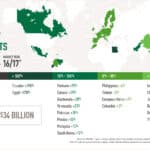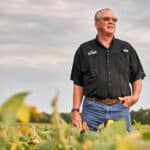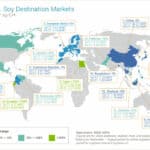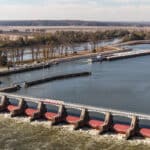ST. LOUIS (Sept. 8, 2022) — The U.S. Soybean Export Council (USSEC), with support from the soy checkoff, hosted more than 600 industry representatives at Soy Connext, the global U.S. soybean summit, in San Diego, California, last month. Attendees included over 400 international U.S. Soy customers from 50 countries and 200 U.S. soybean farmers and industry leaders. USSEC, developed in 2006 by farmer-leaders from the American Soybean Association and the United Soybean Board (USB), is dedicated to building preference, improving value and enabling market access for U.S. soybeans.
“We’re so glad to have had the opportunity to come together in person to strengthen relationships with U.S. Soy’s international customers and industry partners,” said Jim Sutter, USSEC CEO. “During this year’s forum, we heard three recurring themes — we’re in transformative and volatile times, supply chains continue to face challenges and consumers are calling for reduced carbon footprints and increased transparency. Soy Connext provided an excellent forum to collaborate so companies can leverage U.S. Soy’s superior quality, reliability and sustainability in response to these challenges.”
According to USSEC, global soy consumption has exceeded global soy production for the past three years (2019-22). Additionally, soy consumption and production over the past 20 years has doubled. Soybeans continue to be the United States’ No. 1 food and agricultural export.
“Climatic, economic and geopolitical events are testing the resilience of the global food system. Uncertainty is the word of the day. We are honored that international companies are rewarding soy’s low carbon footprint, optimal nutritional bundle, high refining rate, low refining cost and reliable production and exports by importing record volumes to advance food and nutrition security in the 82 countries we serve,” said Doug Winter, USSEC chair, USB farmer-leader and Illinois farmer.
During the event, USSEC launched the new Soybean Value Calculator, an innovative tool for soybean crushers to calculate and compare the economic value of soybeans from various countries, funded by the soy checkoff. Customers can enter company-specific data along with soybean composition and physical factor data to analyze the potential economic benefit of choosing U.S. soybeans over soy of other origins.
Additionally, USSEC announced that the U.S. Soy Sustainability Assurance Protocol (SSAP) earned Silver Level Equivalence with the Sustainable Agriculture Initiative Platform’s Farm Sustainability Assessment (FSA) 3.0. The SSAP provides verified sustainable soybean production on a national scale for U.S. soybean farmers. The benchmark eases the process for food and beverage sectors to assess, improve and validate on-farm sustainability in their supply chains with U.S. Soy.
The FSA Silver Level Equivalence designation is the latest third-party recognition of the sustainability of U.S. Soy. It joins the European Feed Manufacturers Organization (FEFAC), Global Seafood Alliance: Best Aquaculture Practices — Sustainable Feed, The Consumer Goods Forum, the Tokyo 2022 Olympics and the UK Roundtable on Sustainable Soya, all of which have already positively benchmarked the SSAP.
As part of Soy Connext, the event provided an opportunity for international buyers and customers to visit U.S. soybean farms across 14 soy-producing states to transparently engage with farmers, inspect the crop and discuss challenges, needs and opportunities.
Six stats related to U.S. Soy:
- Global poultry, pork and aquaculture consumption are forecast to grow 17.8%, 13.1% and 23%, respectively, by 2030.
- Global soyfoods per capita consumption grew 24% to 2.67 kg in 2020 from 2.16 kg in 2010.
- U.S. Soy’s top 15 export markets (MY21/22): China, Mexico, EU, Egypt, Japan, Philippines, Indonesia, Colombia, Taiwan, Canada, Bangladesh, Thailand, S. Korea, Pakistan, Ecuador
- U.S. Soy’s top growth markets (21/22 v. 16/17): Egypt, Turkey, Ecuador, Venezuela, Canada, Guatemala, Colombia, Mexico, EU. Bangladesh growing. India potential evolving
- Sustainable U.S. Soy has the lowest carbon footprint when compared with soy of other origins.
- SSAP verified exports are up 33% vs. a year ago, and 58% (approx. 38 MMT) of U.S. Soy’s total exports (approx. 64 MMT) in MY 2021/22 (as of 7/28/22).
About United Soybean Board: United Soybean Board’s 78 volunteer farmer-leaders work on behalf of all U.S. soybean farmers to achieve maximum value for their soy checkoff investments. These volunteers create value by investing in research, education and promotion with the vision to deliver sustainable soy solutions to every life, every day across the three priority areas of Infrastructure & Connectivity, Health & Nutrition, and Innovation & Technology. As stipulated in the federal Soybean Promotion, Research and Consumer Information Act, the USDA Agricultural Marketing Service has oversight responsibilities for USB and the soy checkoff. For more information on the United Soybean Board, visit unitedsoybean.org.
About U.S. Soybean Export Council (USSEC): The U.S. Soybean Export Council (USSEC) focuses on differentiating, elevating preference and attaining market access for the use of U.S. Soy for human consumption, aquaculture and livestock feed in 80+ countries internationally. USSEC members represent the soy supply chain including U.S. Soy farmers, processors, commodity shippers, merchandisers, allied agribusinesses and agricultural organizations. USSEC is funded by the U.S. soybean checkoff, USDA Foreign Agricultural Service (FAS) matching funds and industry. Visit www.ussec.org for the latest information on U.S. Soy solutions and news about USSEC and U.S. Soy internationally.
###
Contact:
Laura Smith at United Soybean Board, 636.728.9087.
Brad Robb at OBP, 901.230.0447.
Chris Samuel, U.S. Soybean Export Council, 314.306.1273.
Kerrey Kerr-Enskat, U.S. Soybean Export Council, 515.823.1848.









